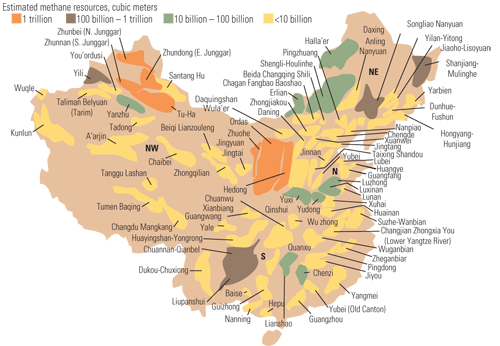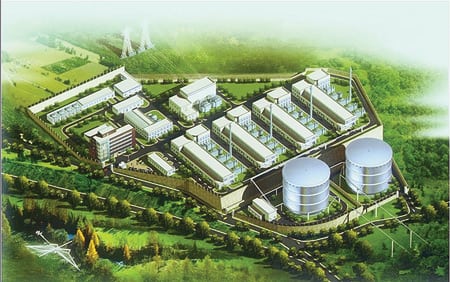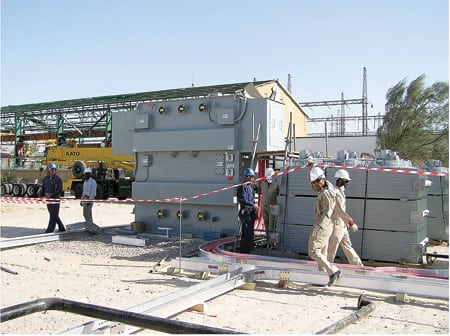U.S. Commercial Service helps suppliers go global
When China joined the World Trade Organization (WTO) in December 2001, market opportunities for U.S. companies expanded by an order of magnitude. China is America’s fastest growing export market, with sales of goods and services up 80% since 2001. Although exports by American companies continue to surge, those looking to do business in China need to remember that no opportunity is without its challenges.
Here’s an example. In the fall of 2005, Caterpillar Inc. (www.cat.com) hoped to win a big contract to supply the engine-generator sets at the heart of a project to build the world’s largest power plant fueled by coal mine methane (Figure 1). The Jincheng Coal Mine Methane Development Project in China’s Shanxi Province (Figure 2) was expected to attract bids from most vendors of gensets worldwide.

1. Just like natural gas. China’s coal basins and coalbed methane resources. Source: Caterpillar Inc.

2. Lemons to lemonade. An artist’s rendering of the Jincheng Sihe 120-MW cogeneration plant. It will cleanly burn methane liberated from coal seams that otherwise would be vented. Courtesy: Caterpillar Inc.
"We knew that a win on this Chinese project would have a lot of ramifications for our company," says Jack Gehring, director of Caterpillar’s International Services division. "A successful bid would set the table for a lot of new business not only in China but in other key markets such as Ukraine, India, and Botswana as well. However, we also knew that we would face intense international competition for the contract."
In the early stages of the bidding process, Caterpillar reached out to the U.S. Commercial Service—the trade promotion unit of the Commerce Department’s International Trade Administration—for any help it could provide. Having done business in China since 1975, Caterpillar was already familiar with the U.S. Commercial Service and its Advocacy Center—the central coordinating office marshaling U.S. government resources to help "level the playing field" on behalf of U.S. businesses as they compete against foreign firms for specific international contracts or other U.S. export opportunities.
Under the Advocacy Center’s Early Project Development initiative, Caterpillar representatives got the latest and best information on the Asian Development Bank’s (ADB) tender for the Jincheng project as early as possible. The Advocacy Center coordinated closely with its liaison to the ADB on project financing issues and with the U.S. Trade and Development Agency (USTDA).
At the recommendation of the U.S. Liaison Office at the ADB, the USTDA agreed to provide a technical assistance grant to oversee the project’s final design specifications and procurement process—making the latter more predictable. The Advocacy Center also worked closely with U.S. Commercial Service officials in Beijing, who met with officials of China’s Ministry of Commerce and sent letters to the vice governor of Shanxi Province and the chairman of Shanxi Jincheng Anthracite Coal Mining Group Co., Ltd.—the project developer and customer.
A win-win outcome
Thanks to those efforts, Caterpillar came to the bidding process well prepared and was awarded a $58 million contract to supply 60 methane-fueled engine-generators and switchgear to the project. The company estimates the contract’s U.S. export content value at about $49 million.
According to Gehring, the contract will create significant employment at Caterpillar’s factories in the U.S. and for its American suppliers as well. For example, the gensets will be built at one Caterpillar plant in Lafayette, Ind., and their control panels will come from another in Griffin, Ga.
According to Gehring, the contract is a great example of how trade between the U.S. and other countries can be positive for both sides. "This is a great example of how having federal backing for a bid can add credibility to the process of convincing potential buyers such as the Chinese to award a contract."
The power plant project, at the Sihe coal mine in Jincheng City, will simultaneously improve safety at the mine and benefit the local community by converting methane into megawatts. To protect underground workers, most coal mines vent to the atmosphere the methane released from seams by excavation. At the Sihe mine, the 60 Caterpillar gensets will use this methane as a clean fuel. For efficiency’s sake, their waste heat will be fed to four steam turbines from Shanghai Electric Group Co., Ltd. Working together, the gensets and turbines will be capable of producing 120 MW. Eliminating the venting should reduce the mine’s greenhouse gas emissions by an estimated 4.5 tons over the next two decades. The power project is slated to come on-line this year.
"[At Sihe,] we’re doing more than using a ‘green’ generation technology; we’re also helping to advance China’s rural electrification initiative," says Gehring. "The great thing about this project is that it’s not only good for our business. It also really helps improve the quality of people’s lives, and that makes it all the more worthwhile."
Become a proactive exporter
The Caterpillar success story is just one example of how the Commercial Service and its Advocacy Center are working to help thousands of U.S. companies compete overseas. The service has a seamless network of trade specialists in 109 cities and at American embassies and consulates in nearly 80 countries. To locate the office nearest you, visit www.export.gov. As a reader of POWER, you’ll likely be most interested in the Commercial Service’s Energy Team, whose members have expertise in power production equipment and technologies, and generation fuels.
You don’t have to be a big firm like Caterpillar to benefit from exporting and the programs of the Commercial Service. In fact, the vast majority of all U.S. exporters are companies with fewer than 100 employees. More than 80% of the service’s clients are small and midsize businesses.
The importance of exporting is well-known: It helps companies to compete and diversify their portfolios in world markets, which contributes to the U.S. economy and job growth. Yet, although many smaller providers of power equipment and services are able to reactively meet demand in the global economy, fewer have given serious thought to becoming "proactive exporters."
Proactive exporting is an ongoing strategy that must be supported by a company’s top management. Often, that support is lacking because managers believe that exporting is too time-consuming or challenging, and that companies must do it alone. However, the reality is that although exporting always carries some risk, the risks of not exporting are greater. After all, more than 70% of the world’s purchasing power lies beyond America’s borders.
Indeed, there has never been a better time to be a proactive exporter:
- With the growing number of free trade agreements, the Internet, lower-cost transportation, and the availability of government support for exporters, there are excellent opportunities for firms to expand their sales overseas.
- The U.S. Commercial Service offers more resources to exporters than ever before. It can help your company navigate the avenues of trade through comprehensive export counseling, market research, trade events, advocacy, prearranged business appointments abroad, international partner searches, and many other services. It also can put you in touch with financing partners through its strong relationships with the U.S. Export-Import Bank, the U.S. Small Business Administration, and other relevant entities. It can even help clear up a bureaucratic bottleneck in a "country of destination" see box).
- Highly respected worldwide for their technological innovation, engineering, and reliability, American power generation technologies already have a competitive leg up. Demand for those technologies will continue to grow in parallel with worldwide demand for electricity.
Although many companies have yet to take advantage of export opportunities, almost as many others are well on their way to achieving their export goals with help from the U.S. Commercial Service network. This article concludes with three brief case histories of successful exporting experience.
Unalloyed success
Back in the early 1930s, when Garfield Edmonds made a loan to some friends to help finance a small machine shop, little did he know that he would soon be a partner in the business. Years later, his grandson, Bill Edmonds, would become a third-generation partner and the international sales manager of what is now a family-owned company, B&G Manufacturing of Hatfield, Pa. (www.bgmfg.com).
Among other things, the company manufactures high-strength, high-temperature "super" alloy fasteners that are based on nickel and used to hold components together in power turbines. B&G’s product line also includes a machine that makes the bolts used to join the flanges at the ends of pipeline segments.
B&G began exporting on its own in the 1970s and a few years later heard about the U.S. Commercial Service from a business partner. Edmonds says his first stop was the U.S. Export Assistance Center in Trenton, N.J., where he reviewed his product line and market objectives with a Commercial Service trade specialist.
"We make parts that must endure high stress and extreme temperatures, much like you would find in a jet engine, only on a bigger scale," explains Edmonds. "Some of our fasteners can be held in your hand; others are large bolts that weigh up to a half-ton."
Why did Edmonds make that first visit to Trenton decades ago? He remembers being convinced that his potential prospects of selling to Mexico and Europe were good but realizing that he needed export counseling and market research to advance the process—or, as he says, "to put B&G over the top."
Soon afterward, the Commercial Service began working with B&G to develop entry-level market strategies for each of the countries it wanted to target. The firm was given—free of charge—analyses of the countries’ energy sectors, current and future market prospects, and leads on proposed energy projects.
According to Edmonds, he next signed up for the Commercial Service’s Gold Key Matching Service and flew out to the specified countries to meet with several potential agents and distributors. Prior to his departure, Gold Key Service employees prescreened the prospects and arranged the meetings, which ultimately led to sales of fasteners to Mexico, Italy, France, and the United Kingdom.
"[This step] would have taken much longer, had I made it alone," says Edmonds, "One of the biggest advantages of using the Gold Key Service is the first-hand market intelligence and leg up on the competition it provides. They enabled me to better understand my target markets and the challenges my potential customers face in them. Being able to see the landscape from a customer’s point of view is always good for business."
For example, Edmonds says he has gained insight into foreign distribution mechanisms, the financing and supply-line aspects of how particular markets work, and the ability to evaluate competition in markets. He adds that involving his firm in international trade has allowed it to retain jobs at its manufacturing facilities.
Passage to India
Smitty Ovitt, Asia-Pacific Director of Xantrex Technologies Inc., has a knack for converting sales leads into export sales. But when it comes to converting electrical energy, he leaves that to his company’s line of products. Among the advanced power equipment that Xantrex (www.xantrex.com) designs and builds are inverters that convert the DC power generated by solar cells and windmills to AC, making it compatible with transmission and distribution grids.
In 2003, not long after Ovitt had established a relationship with the U.S. Export Assistance Center in Oakland, Calif., he received a call from the center. "We were told that a delegation of Indian buyers was arriving on the West Coast as part of a trade mission sponsored by the Commercial Service in New Delhi, India, and its partners," Ovitt remembers. "I was encouraged to meet with the delegates and saw it as an excellent opportunity to ramp up my export sales to India."
Sensing opportunity, Ovitt agreed to the meetings and was prepared for them by the Commercial Service. He was told of the new renewable energy subsides such as investment incentives and tax breaks being offered by both New Delhi and state governments. Separately, Commercial Service trade specialists thoroughly briefed the Indian delegation on what U.S. firms like Xantrex had to offer them.
"India had not been at the top of our list of potential export markets," Ovitt admits. "But the trade mission and the counseling really made clear the huge business opportunities it offers. We were incentivized to pursue Indian sales opportunities, and we have nurtured business relationships that have continued to develop through additional visits by Indian delegations, most recently in August 2006."
Ovitt couldn’t be selling to India at a better time—India’s renewable energy market is estimated at $500 million and is experiencing annual double-digit growth.
"As a medium-sized company with the majority of our resources devoted to North America and Europe, it would have been difficult to sell to India on our own," Ovitt says. "We found the contacts and insights provided by the Commercial Service to be invaluable."
Today, having sold a substantial number of inverters to India, Ovitt takes pride in his company’s contribution to renewable energy’s worldwide inroads on fossil-fuel combustion. He thinks globally, while his Indian customers act locally. One customer—Team Sustain Ltd., a provider of "green" engineering solutions—is using Xantrex equipment to improve the efficiency of hotels and other buildings with environmentally friendly heating and cooling systems.
"Exporting has become increasingly important to our company’s overall growth," Ovitt realizes. "Our experience with India will definitely be helpful as we look to expand our export sales throughout Asia."
Spanning the globe
After earning a degree in electronic and telecommunication engineering from an Indian university a few years ago, Alok Mandal took on another challenge—selling overseas as director of export and transit sales for Virginia Transformer Corp. (VTC). "It’s a great time to be exporting," he says, "and I’m busier than ever."
Based in Roanoke, Va., VTC (www.vatransformer.com) is a minority-owned firm that manufactures custom transformers used by firms in the mining, petrochemical, steel, paper, mass-transit, and electric power industries (Figure 3). Its product line is broad, encompassing everything from two-ton step-up and step-down distributions transformers working at 440V and 240V to 100-ton, 138-kV units suitable for a regional transmission grid.

3. Transforming the world. A voltage converter from Virginia Transformer Corp. awaits installation at an infrastructure project. Virginia Transformer Corp.
VTC began by selling its transformers strictly in the U.S. By the early 1980s, the company had booked its first export sales and was looking to expand its international presence. To do so, Mandal contacted the U.S. Commercial Service in Richmond, Va. He credits the partnership for VTC’s first win in a new country—Mexico. But much more was to come.
"About six years ago, we knew Mexico had great potential for us, but we needed to better understand the finer points of doing business there," Mandal recalls. "Our man in Richmond alerted us that the Commercial Service in Mexico City was sponsoring a series of business seminars on Mexican contract law, export licensing, customs, and other issues. We attended them all—I think it was one of the best business decisions VTC has ever made—and by our second year in the market we had doubled our annual export sales to several hundred thousand dollars."
Buoyed by the success, VTC decided to use the Gold Key Matching Service to expedite its entry into several unfamiliar markets—Jordan, Kuwait, the Philippines, and the United Arab Emirates (UAE). The counseling and prescreening of contacts paid dividends in the form of a big contract with Jordan’s state-owned power company and deals with new distributors in Kuwait, the Philippines, and the UAE.
According to Mandal, VTC’s most promising export markets continue to be Mexico and Canada. But he also sees great potential in Central America and the Caribbean. "In exporting, growth is the name of the game, and our sales overseas have expanded more than 400% over the past decade," he says. "We now have customers in over 40 countries, and their purchases are directly responsible for many of the local jobs we’ve added."
Mandal’s advice for would-be exporters? "Don’t be afraid to take the leap. Pinpoint your target markets, determine how you’ll balance your export business with your domestic business, and then call your local U.S. Commercial Service office to help execute your strategy."
—Israel Hernandez is assistant secretary for trade promotion and director general of the U.S. Commercial Service. More information on the trade promotion unit is available by visiting www.ita.doc.gov/cs or calling 1-800-USA-TRAD(E). The U.S. Government’s Export Portal is located at www.export.gov.